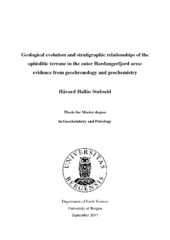Geological evolution and stratigraphic relationships of the ophiolitic terrane in the outer Hardangerfjord area: evidence from geochronology and geochemistry
Master thesis

Åpne
Permanent lenke
https://hdl.handle.net/1956/16756Utgivelsesdato
2017-10-13Metadata
Vis full innførselSamlinger
- Department of Earth Science [1103]
Sammendrag
Field relations, geochemistry and U-Pb single zircon ages have provided new information about the rocks of the outer Hardangerfjord area that represent a part of the Upper Ordovician ophiolitic terrane of south-western Norway. Trace element compositions of the basaltic greenstones and the volcanogenic sedimentary sequence of the Varaldsøy-Ølve Complex (VØC) indicate supra subduction zone (SSZ) affinity. This is similar to other ophiolitic and immature island arc sequences in the Sunnhordland region formed around 490 Ma. The immature island arc sequences are unconformably overlain by more mature island arc volcanics. This is represented by the rhyolitic lavas of the Huglo Formation now dated to around 473 Ma, similar to the Siggjo and Kattnakken Volcanics. The metasedimentary Mundheim Group has been correlated with the sediments of the Vikafjord Group on Bømlo, based on similarities in the zircon populations. This sedimentary sequence is suggested to have been deposited in a marginal basin formed by rifting of the Laurentic margin. Sediment provenance of volcaniclastic rocks present at the base of the Mundheim Group on Varaldsøy suggest a local source of sediment from the Huglo Formation, or other volcanic sources with a similar age and affinity. This is based on the geochemical similarities and that the dominant zircon population has a similar age as the rhyolitic volcanics in the region. The quartzites and metasandstones in the area reveal multiple sediment sources dominated by Proterozoic grains, with a minor influence of an Archean source. This suggests that these complexes were formed adjacent to a continental margin. These sediments are overlain by a thick pile of limestones with Sr isotopic compositions suggesting a deposition age of 445-460 Ma. The limestones are deposited directly on top of the quartzites/metasandstones. Further development of this basin led to a transgression resulting in reducing condition. The limestones are covered in pelagic metasediments, such as phyllites and mica schists. By combining previous knowledge about the region with the findings from this study, we have been able to improve our understanding of the outboard terrane in the Hardangerfjord area. A geological evolution is presented together with a renewed stratigraphy for the outer Hardangerfjord area.